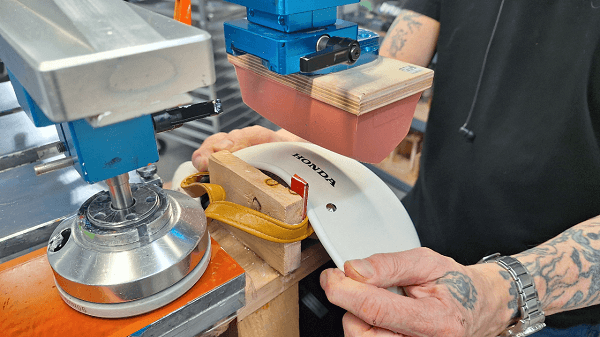In a world filled with various printing techniques, pad printing stands out as a versatile and effective method for transferring images onto irregular, three-dimensional surfaces. Whether you’re marking medical products, branding promotional items, or personalizing gifts, this printing method offers a great solution. Within this post, we’ll explore the fascinating world of pad printing, including its history, the process, applications, and why it continues to be a valuable tool in the realm of printing.
In addition too, if you have a need for pad printing services, Accumark Inc can help – contact us today!
History of Pad Printing
Pad printing has a rich history dating back to the 1960s. This printing technique was initially developed in Europe as a way to print on irregular and uneven surfaces, a task that traditional printing methods, like screen printing, couldn’t handle effectively. It was originally used for marking ceramic and glass products, but over time, its applications expanded significantly.

The Pad Printing Process
This method of printing is a photogravure process that involves several key steps to transfer an image onto various surfaces. Here’s a simplified overview of the process:
- Artwork Preparation: The first step is to create or obtain the desired artwork that you want to print. This can be a company logo, a design, or any image you want to transfer.
- Plate Creation: The artwork is etched onto a printing plate, which serves as the template for the image. This plate can be made of metal, plastic, or other materials.
- Ink Mixing: Specific inks are mixed to achieve the desired colors. These inks should also be compatible with the material you’re printing on and from there, should be capable of adhering to it.
- Inking the Plate: The etched plate is coated with ink, and excess ink is wiped away, leaving ink only in the etched recesses.
- Transferring the Image: A silicone pad, which is flexible and can conform to the shape of the object, picks up the ink from the plate and transfers it to the target surface.
- Curing and Drying: The printed item is typically passed through a curing process to ensure the ink adheres properly. This may involve exposure to UV light, heat, or air drying, depending on the type of ink used.
Applications of Pad Printing
Pad printing is incredibly versatile. This makes it suitable for a wide range of applications. The following are some common uses of pad printing:
- Promotional Products: Used to brand various promotional items such as pens, keychains, and mugs.
- Electronic Devices: Many electronic devices feature pad-printed labels. These devices include things such as keyboards, remote controls, headphone cases, and speakers.
- Aerospace and ITAR: Many parts that see use in Aerospace and ITAR projects require identification markings.
- Medical Equipment: Medical instruments and equipment often use printing to mark measurements and indicators.
- Toys and Games: The toy industry relies on printing for adding colorful graphics to toys and games.
- Automotive Parts: Used to add logos and markings on automotive components.
- Home Appliances: Household appliances like washing machines and coffee makers may have printed labels and controls.
- Sporting Goods: From golf balls to hockey pucks, sporting goods often have printed logos and designs.

Why Is This Form of Printing Still Relevant
Despite the advancements in digital printing technology, pad printing remains a popular choice for many applications. Here are a few reasons why pad printing is still relevant:
- Versatility: Pad printing can handle a wide variety of substrates and shapes, making it ideal for irregular surfaces and 3D objects.
- Durability: The ink used is highly resistant to wear and tear, making it perfect for items that undergo frequent use and handling.
- Cost-Effective: For many small and medium-scale production runs, it can be more cost-effective than alternative methods like screen printing.
- Speed and Efficiency: The pad printing process is relatively quick and efficient, which is essential for meeting production deadlines.
In conclusion
Pad printing is an art that has evolved over the years. It provides businesses with a reliable as well as flexible means of transferring images onto various surfaces. Whether you’re branding products, adding graphics to promotional items, or personalizing gifts, pad printing is a versatile and cost-effective solution that continues to thrive in today’s diverse printing landscape. As technology continues to advance, pad printing remains a valuable tool for creating lasting impressions on a multitude of surfaces.
Does your company require pad printing for a specific job? Accumark Inc In Hudson Wisconsin can help. Contact us today for your project’s pad printing needs.
